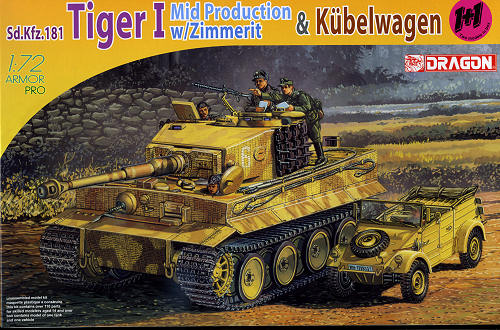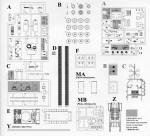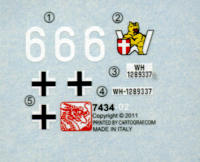
Dragon 1/72 Tiger I mid w/Zimmerit & Kubelwagen
| KIT #: | 7434 |
| PRICE: | $23.50 SRP |
| DECALS: | One option |
| REVIEWER: | Scott Van Aken |
| NOTES: | New tool Kubelwagen |

| HISTORY |
The Tiger differed from earlier German tanks principally in its design philosophy. Its predecessors balanced mobility, protection, and firepower. They were sometimes outgunned by their opponents, but greatly superior German tactics offset this disadvantage.
The Tiger I represented a new approach that emphasized firepower and armour at the expense of mobility. Design studies for a new heavy tank had been started in the late 1930s, without any production planning. The real impetus for the Tiger was provided by the quality of the Soviet T-34. Although the general design and layout were broadly similar to the previous medium tank, the Panzer IV, the Tiger weighed more than twice as much. This was due to its substantially thicker armour, the larger main gun, and the consequently greater volume of fuel and ammunition storage, larger engine, and more solidly-built transmission and suspension.
The Tiger I had frontal hull armour 100 mm thick and frontal turret armor of 110 mm, as opposed to the 80 mm frontal hull and 50 mm frontal turret armour of contemporary models of the Panzer IV. It also had 80 mm thick armour on the sides and rear. The top and bottom armour was 25 mm thick; later, the turret roof was thickened to 40 mm. Armour plates were mostly flat, with interlocking construction. The armour joints were of high quality, being stepped and welded rather than riveted.
The tank was too heavy for most bridges, so it was designed to ford four-metre deep water. This required unusual mechanisms for ventilation and cooling when underwater. At least 30 minutes of setup was required, with the turret and gun being locked in the forward position, and a large snorkel tube raised at the rear. Only the first 495 examples were fitted with this deep fording system, all later models were only capable of fording two metres.
The rear of the tank held an engine room flanked by two floodable rear compartments each containing a fuel tank, radiator, and fans. The petrol (gasoline) engine was a 21-litre 12-cylinder Maybach HL 210 P45 with 650 PS (641 hp, 478 kW). Although a good engine, it was inadequate for the vehicle. From the 250th Tiger it was replaced by the uprated HL 230 P45 (23 litres) of 700 PS (690 hp, 515 kW). The engine was inline, with two cylinder banks at 60 degrees. An inertial starter was mounted on its right side, driven via chain gears through a port in the rear wall. The engine could be lifted out through a hatch on the hull roof.
The engine drove front sprockets, which were mounted quite low. The eleven-ton turret had a hydraulic motor powered by mechanical drive from the engine. A full rotation took about a minute. The suspension used sixteen torsion bars. To save space, the swing arms were leading on one side and trailing on the other. There were three road wheels on each arm, giving a good cross-country ride. The wheels had a diameter of 800 mm and were interleaved. Removing an inner wheel that had lost its tire (a common occurrence) required several outer wheels to be removed also. The wheels could become packed with mud or snow that could then freeze. Eventually a new 'steel' wheel design, with an internal tire was subsituted.
The tracks were an unprecedented 725 mm wide. To meet rail-freight size restrictions the outer row of wheels had to be removed and special 520 mm wide transport tracks installed. With a good crew, a track change took 20 minutes.
The internal layout was typical of German tanks. Forward was an open crew compartment, with the driver and radio-operator seated at the front, either side of the gearbox. Behind them the turret floor was surrounded by panels forming a continuous level surface. This helped the loader to retrieve the ammunition, which was mostly stowed above the tracks. Two men were seated in the turret; the gunner to the left of the gun, and the commander behind him. There was also a folding seat for the loader. The turret had a full circular floor and 157 cm headroom.
The gun breech and firing mechanism were derived from the famous German "88" dual purpose flak gun. The 88 mm Kwk 36 L/56 gun was the variant chosen for the Tiger and was, along with the Tiger II's 88 mm Kwk 43 L/71, one of the most effective and feared tank guns of WW2. The Tiger's gun had a very flat trajectory and extremely accurate Zeiss TZF 9b sights. In British war-time firing trials, five successive hits were scored on a 16"x18" target at a range of 1,200 yards. Tigers were reported to have knocked out enemy tanks at ranges greater than a mile (1,600 m), although most WW2 engagements were fought at much closer range.
Another new feature was the hydraulically-controlled pre-selector gearbox and semi-automatic transmission. The extreme weight of the tank also meant a new steering system. Instead of the clutch-and-brake designs of lighter vehicles, a variation on the British Merritt-Brown single radius system was used. The Tiger's steering system was of twin radius type, meaning that two different, fixed radii of turn could be achieved at each gear, the smallest radius on the first gear was four metres. Since the vehicle had an eight-speed gearbox, it thus had sixteen different radii of turn. If a smaller radius was needed, the tank could be turned by using brakes. The steering system was easy to use and ahead of its time. However, the tank's automotive features left much to be desired. When used to tow an immobilized Tiger, the engine often overheated and sometimes resulted in an engine breakdown or fire, for which reason Tiger tanks were forbidden by regulations to tow crippled comrades. The low-mounted sprocket limited the obstacle-clearing height. The tracks also had a bad tendency to override the sprocket, resulting in immobilization. If a track overrode and jammed, two Tigers were normally needed to tow the tank. The jammed track was also a big problem itself, since due to high tension, it was often impossible to disassemble the track by removing the track pins. It was sometimes simply blown apart with an explosive charge. The standard German Famo recovery tractor could not tow the tank; up to three tractors were usually needed to tow one Tiger.
Although the Tiger I was one of the most heavily armed and armoured tanks of WWII, and a formidable opponent of Allied tanks, the design was conservative and had some serious drawbacks. The flat armour plates were unsophisticated in comparison to the sloped armour of the Soviet T-34, requiring a massive increase in weight to provide for sufficient protection. The tank's weight put severe stress on the suspension, whose complexity made maintenance difficult. The sophisticated transmission system was also prone to breakdowns.
A major problem with the Tiger was its very high production cost. During the Second World War over 40,000 American Sherman and 58,000 Soviet T-34s were produced, compared to 1,355 Tiger I and some 500 Tiger II tanks. The German designs were expensive in terms of time, raw materials and Reichsmarks, the Tiger I costing over twice as much as a contemporary Panzer IV and four times as a Stug III assault gun. The closest counterpart to the Tiger from the United States was the M26 Pershing (around 200 deployed during the war) and IS-2 from the USSR (about 3,800 built during the war).
| THE KIT |
 Adding to their growing Armor Pro collection is this very nice mid-production Tiger I that comes with a Kubelwagen. It is marketed as a 1+1 kit, which in the past has meant two of the same kit, but in this case they are different. The Kubelwagen measures at about 2 inches and this newly tooled vehicle is really nicely done and quite detailed. It will look great next to your Jeeps or in a diorama. I found that this vehicle has DS tires along with the interior passenger walls and the folded top. The mufflers and exhaust are also DS molds. The front doors are separate and perhaps one could pose them open.
Adding to their growing Armor Pro collection is this very nice mid-production Tiger I that comes with a Kubelwagen. It is marketed as a 1+1 kit, which in the past has meant two of the same kit, but in this case they are different. The Kubelwagen measures at about 2 inches and this newly tooled vehicle is really nicely done and quite detailed. It will look great next to your Jeeps or in a diorama. I found that this vehicle has DS tires along with the interior passenger walls and the folded top. The mufflers and exhaust are also DS molds. The front doors are separate and perhaps one could pose them open.
The Tiger itself is what uses the photo etch that is included in the kit. There are photo etch parts for the exhaust shrouds, making them nice and thin. The other p.e. fret includes engine screens, grab handles, brackets and a ring for the inside of the hatch. Some of these replace extant plastic parts and to use them some trimming needs to be done. I especially like that most of the road wheels are molded on a single construct. Though it will not alleviate painting the tires, it will make them easier to handle. The DS tracks are also quite welcome. These may need to be stretched or trimmed to fit so be sure to do that prior to installation.
The rest of the features are listed below:
- Detailed Kübelwagen newly produced
- Turret and mantlet with realistic zimmerit pattern
- Upper and bottom hull zimmerit details
- Driver’s panel w/detailed interior
- Transparent windshield is accurately replicated
- Realistic fabric weather cover
- Full chassis represented
- One piece sprocket and idler wheel in great detail
- Road wheels injected as one unit – convenient to assemble and saves time - One-piece slide-molded barrel w/hollowed muzzle brake
- One-piece slide-molded barrel w/hollowed muzzle brake
- Preformed metal exhaust covers
- Delicate wheels w/authentic tread pattern
- Metal cable included
- Photo-etched parts recreated
- One piece DS tracks
The markings are what are shown on the box art. The Tiger I decals provide tactical markings for the 1st Company of the 506th Heavy Tank Battalion. The kubelwagen decals are simply license plates.
| CONCLUSIONS |
A superb addition to their Armor Pro series and a great way to get two very nice models in one box. Thanks to only having 117 pieces, this one should be a pretty rapid build.
| REFERENCES |
January 2012
Thanks to www.dragonmodelsusa.com for the preview kit. Get yours today at your local shop or favorite on-line retailer.
If you would like your product reviewed fairly and fairly quickly, please contact the editor or see other details in the